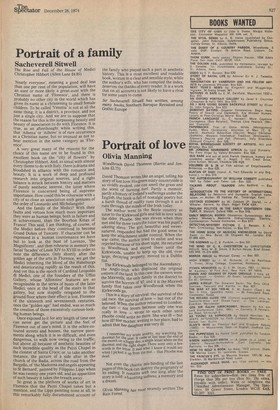Portrait of a family
Sacheverell Sitwell
The Rise and Fall of the House of Medici Christopher Hibbert (Allen Lane £4.95)
'Nearly everyone', meaning a good deal less than one per cent of the population, will have an aunt or more likely a great-aunt with the Christian name of 'Florence', and there is probably no other city in the world which has given its name at a christening to small female children, To be called 'Venetia' is not at all the same thing; it is a district, a province, and not Just a single city. And we are to suppose that the reason for this is the surpassing beauty and beauty of association to do with Florence. It is true, as an afterthought while writing this, that 'Athena' or 'Athene' is of rare occurrence as a Christian name, but so unusual as not to bear mention in the same category as `Florence'.
A very great many of the reasons for the choice of this name are to be found in this excellent book on the "city of flowers" by Christopher Hibbert. And, as usual with almost every theme to do with Italy, there is drama and bloodshed in alliance with the romance and, beauty. It is a work of deep and profound research into original sources, and a right balance is struck between history and matters of purely aesthetic interest, the latter where Florence is concerned being of supreme importance. How could this be otherwise with a city of so close an association with geniuses of the order of Leonardo and Michelangelo!
And the family of the Medici? With their faults and virtues how much more important they were as human beings, both in failure and in achievement, than the Bourbon Kings of France! This said, I am thinking, of course, of the Medici before they contrived to become Grand Dukes of Tuscany. If character can be expressed in a human countenance we have but to look at the bust of Lorenzo, `the Magnificent', and then rehearse in memory the facial 'facades' of Louis XIV to XVIII in order to note the difference. Only shortly after the golden age of the arts in Florence, we get the Medici inheriting the blood of the Habsburgs and deteriorating rapidly as the result of this. And yet this is the epoch of Cardinal Leopoldo di Medici, one of the founders of the Uffizi Gallery, whose 'Alfonsine' features are so recognisable in the series of busts of the later Medici, once at the head of the stairs in that gallery, but now stupidly relegated to the ground floor where their effect is lost. Florence of the sixteenth and seventeenth centuries, once the "golden age" had ended, was so much the creation of these excessively curious-looking human beings.
Once exposed to it for any length of time one can never get the picture and the feel of Florence out of one's mind. It is the ochre-coloured streets and houses, the narrow pavements along which it is so difficult, and even dangerous, to walk now owing to the traffic; but above all because of aesthetic beauties of such incredible quality as the Pazzi Chapel in the cloister of Santa Croce; or, to take another instance, the picture of a side altar in the church of the Badia, across the road from the Bargello, of 'the Madonna and angels appearing to St Bernard', painted by Filippino Lippi when he was twenty-one years old, and an apparition of such beauty it takes the breath away.
So great is the plethora of works of att in Florence that the Pazzi Chapel takes but a mention, and the Lippi painting none at all, in this remarkably fully documented account of the family who played such a part in aesthetic history. This is a most excellent and readable book, written in a clear and sensible style; while the author's wife, who has compiled the index, deserves the thanks of every reader. It is a work that on all accounts is not likely to have a rival for some years to come.
Sir Sacheverell Sitwell has written, among many books, Southern Baroque Revisited and Gothic Europe














































 Previous page
Previous page